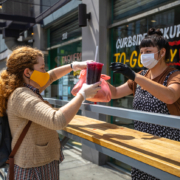Sounds Like A Plan, Right?

Droplets vs. aerosol. That’s been the debate around COVID-19 transmissability—and it’s politically and scientifically fraught. Up until recently, many in the scientific community have insisted that droplets were key to COVID-19 transmission, not aerosols. The difference is size. Droplets are the rather large particles we emit when we sneeze, for instance. Aerosols are the fine, airborne mists that we emit while speaking, or just breathing. Aerosols linger in the air; droplets fall to the ground. Removing aerosols from the equation meant that the disease was not airborne, meaning the disease was harder to catch. Here’s a good droplet vs. aerosol explainer video from The Washington Post.
Well, not so fast. Back in August, the University of Minnesota’s Center for Infectious Disease Research and Policy (CIDRAP) reported on studies supporting aerosol, or airborne transmission. Even earlier studies had documented airborne spread in semi-enclosed environments such as a choir practice and in a restaurant.
The CDC however, only acknowledged airborne transmission on October 5. Why does this matter? It means that enclosed spaces are a higher transmission risk. It means that just speaking or breathing can transmit infectious aerosols. It means that the disease is more transmissible, which reinforces the importance of masks, especially in indoor areas, and good ventilation. These facts are politically inconvenient in some circles.
Happily, the same guidance we got way back at the beginning of the pandemic continues to offer the best protection—even in the face of aerosol transmission: masks, social distancing, and hand washing.
Sounds like a plan if more of us would just stick to it.
– Leonce Gaiter, Vice-President, Content & Strategy








